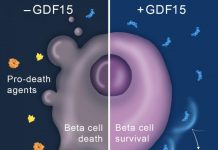April 2010 - Using a sophisticated nanotechnology-based "vaccine," researchers were able to successfully cure mice with type 1 diabetes and slow the onset of the disease in mice at risk for the disease.
The study, co-funded by the Juvenile Diabetes Research Foundation, provides new and important insights into understanding how to stop the immune attack that causes type 1 diabetes, and could even have implications for other autoimmune diseases.
The study, conducted at the University of Calgary in Alberta, Canada, was published today in the online edition of the scientific journal Immunity.
The research was led by Dr. Pere Santamaria from the Julia McFarlane Diabetes Researchers Center at the University of Calgary, Alberta. The researchers were looking to specifically stop the autoimmune response that causes type 1 diabetes without damaging the immune cells that provide protection against infections - what is called an "antigen-specific" immunotherapy. Type 1 diabetes is caused when certain white blood cells (called T cells) mistakenly attack and destroy the insulin-producing beta cells in the pancreas.
Antigen-specific immunotherapies, like Dr. Santamaria's work on nanovaccines, are a priority within JDRF's Immune Therapies program.
Continue Reading Below ↓↓↓
"Essentially there is an internal tug-of-war between aggressive T-cells that want to cause the disease and weaker T cells that want to stop it from occurring," said Dr. Santamaria, who is a JDRF Scholar - a research award to academic scientists taking innovative and creative approaches to better treating and curing type 1 diabetes and its complications.
The researchers developed a unique vaccine comprised of nanoparticles, which are thousands of times smaller than the size of a cell. These nanoparticles are coated with protein fragments - peptides - specific to type 1 diabetes that are bound to molecules (MHC molecules) that play a critical role in presenting peptides to T cells.
The nanoparticle vaccine worked by expanding the number of peptide-specific regulatory T cells that suppressed the aggressive immune attack that destroys beta cells. The expanded peptide-specific regulatory cells shut down the autoimmune attack by preventing aggressive autoimmune cells from being stimulated by either the peptide contained in the vaccine or by any other type 1 diabetes autoantigen presented simultaneously on the same antigen presenting cell.
The research also provided an important insight into the ability to translate these findings in mice into therapeutics for people with diabetes: nanoparticles that contained human diabetes-related molecules were able to restore normal blood sugar levels in a humanized mouse model of diabetes.
According to Teodora Staeva, Ph.D., JDRF Program Director of Immune Therapies, a key finding from the Alberta study is that only the immune cells specifically focused on aggressively destroying beta cells (or, alternatively, regulating these cells) responded to the antigen-specific nanoparticle vaccine.
That means the treatment did not compromise the rest of the immune system - a key consideration for the treatment to be safe and effective in an otherwise healthy person with type 1 diabetes. "The potential that nanoparticle vaccine therapy holds in reversing the immune attack without generally suppressing the immune system is significant," said Dr. Staeva.
"Dr. Santamaria's research has provided both insight into pathways for developing new immunotherapies and proof-of-concept of a specific therapy that exploits these pathways for preventing and reversing type 1 diabetes."
Dr. Santamaria noted that the study had implications for other autoimmune diseases beyond type 1 diabetes. "If the paradigm on which this nanovaccine is based holds true in other chronic autoimmune diseases, such as multiple sclerosis, rheumatoid arthritis, and others, nanovaccines might find general applicability in autoimmunity," he said.
The nanoparticle vaccine technology used in the study has been licensed by Parvus Therapeutics, Inc., a biotechnology company arising from the University Technology International LP, the technology transfer and commercialization center for the University of Calgary. Parvus Therapeutics is focused on the development and commercialization of the nanotechnology-based therapeutic platform for the potential treatment of type 1 diabetes.
Source: Juvenile Diabetes Research Foundation International
Continue Reading Below ↓↓↓









